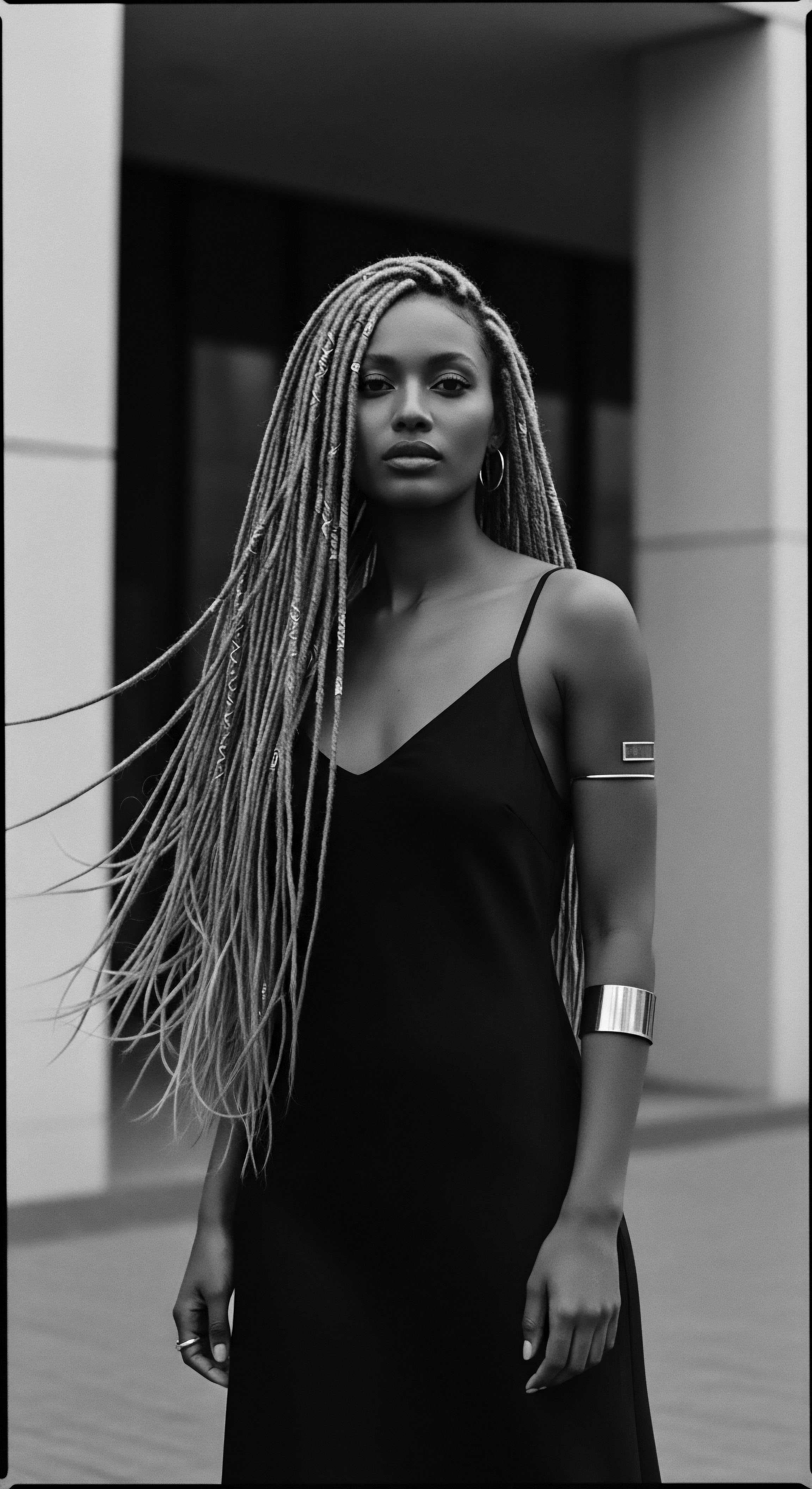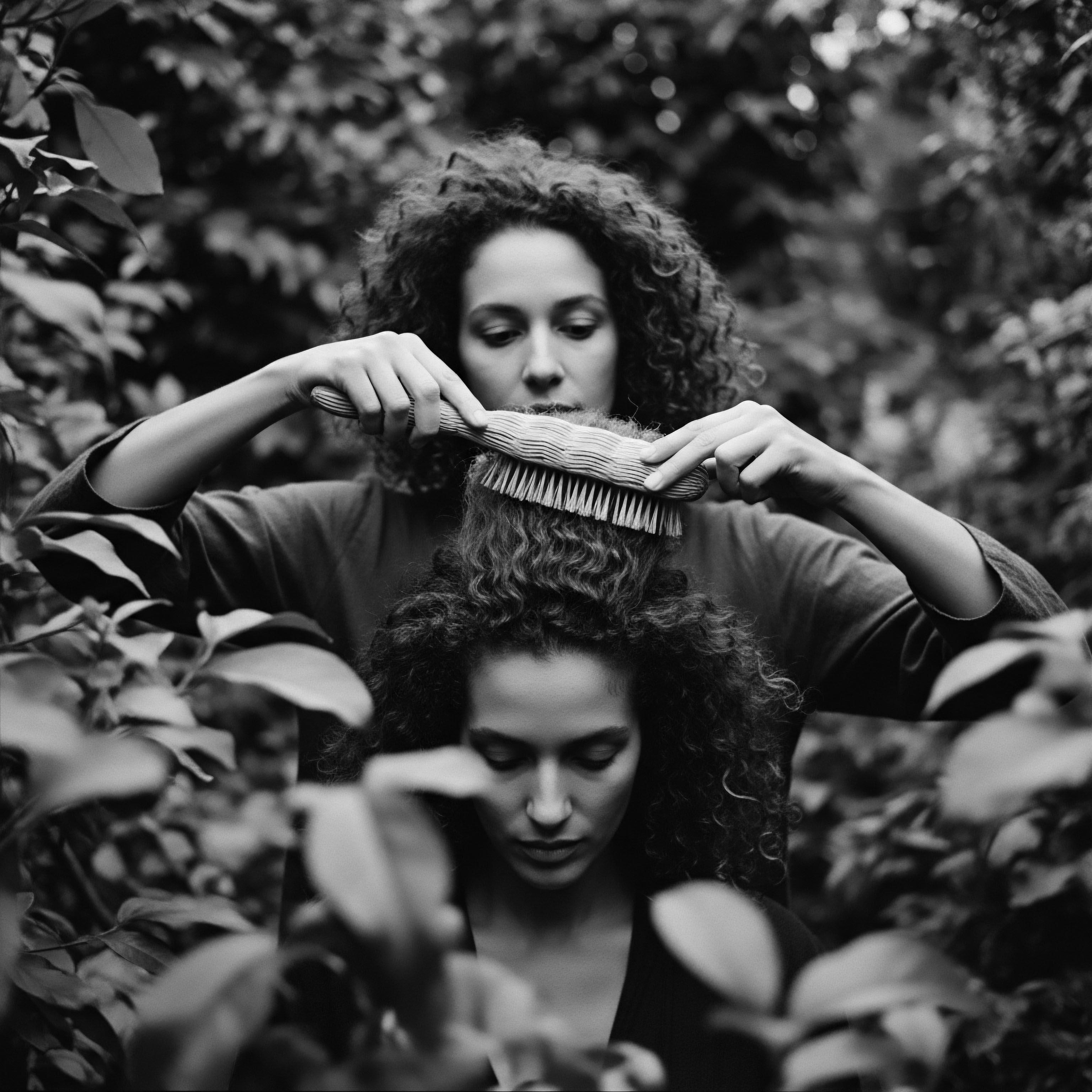
Roots
Consider for a moment the resilient spirals and coils that crown us, a profound testament to ancestry and survival. Each strand, a living archive, whispers stories across generations, holding within its very structure the indelible marks of history – not merely the tales of triumph and adversity, but the quiet, foundational shifts that began within the body itself. We speak of hair often as an outer adornment, a canvas for self-expression, yet its vitality is deeply intertwined with the sustenance drawn from the earth, the very nutrients that nourish its growth.
For those whose lineage traces back through the currents of the diaspora, this connection carries a unique weight, a powerful resonance with textured hair heritage . The profound dietary transformations endured across centuries, from the rich, diverse palettes of ancestral lands to the imposed scarcities and adaptations of new geographies, left an imprint that deserves our thoughtful attention.

Ancestral Diets and Hair’s Beginnings
Before the ruptures, the continents held diverse culinary traditions, each a finely tuned symphony of indigenous crops, wild game, and communal practices. In West Africa, for example, the consumption of nutrient-dense foods like millet, sorghum, yams, leafy greens such as cassava leaves and spinach, and a variety of pulses provided a robust foundation for overall health, including the vibrancy of hair. These diets, rich in complex carbohydrates, plant-based proteins, and essential micronutrients, offered the building blocks for keratin, the protein that forms the hair shaft. Ample iron, often obtained from dark leafy greens and certain meats, supported healthy blood flow to the scalp, a prerequisite for robust hair growth.
Similarly, zinc, found in legumes and nuts, played a crucial role in cell division and repair within the hair follicles. The presence of omega-3 fatty acids from fish and specific plant oils contributed to scalp health and the natural sheen of the hair, preserving its inherent elasticity. This was a diet in accord with the body’s needs, reflective of deep ecological wisdom.

The Disruption of Sustenance
The violent upheaval of the transatlantic slave trade marked a cataclysmic rupture, not only in human lives and cultures but in fundamental dietary practices. Enslaved Africans were forcibly removed from their ancestral foodways, their diets reduced to meager, often nutritionally deficient rations designed for bare survival, not thriving. Staples shifted dramatically to items like cornmeal, salt pork, and molasses – calorically dense yet woefully lacking in vital vitamins and minerals. The persistent scarcity of fresh produce and diverse protein sources led to widespread nutritional deficiencies, impacting every system of the body, including the delicate ecosystem of the hair follicle.
The forced dietary shifts during the transatlantic slave trade left an undeniable, detrimental mark on the nutritional status of textured hair.
Consider the profound deprivation endured ❉ a severe reduction in fruits and vegetables meant a drastic decline in vitamin C, crucial for collagen production and iron absorption. The chronic lack of varied protein sources inhibited the body’s ability to produce sufficient keratin, leading to weakened, brittle strands prone to breakage. Anecdotal historical accounts, though scarce and often filtered through biased lenses, suggest changes in hair texture and vitality among enslaved populations, consistent with signs of severe malnutrition. The once resilient, well-nourished coils faced an unprecedented challenge.
The impact was not uniform across all regions or plantations, yet the overarching pattern was one of systemic deprivation. The body, in its struggle for survival, prioritizes essential physiological functions, diverting precious nutrients away from non-vital processes like hair growth. This biological triage meant that the hair, once a symbol of spiritual connection and community, became a visible marker of hardship and insufficient nourishment. The resilience of Textured Hair, itself a wonder of biological design, was severely tested by these imposed nutritional landscapes.
| Dietary Aspect Macronutrients |
| Ancestral African Practices Balanced complex carbohydrates, diverse plant/animal proteins, healthy fats. |
| Diaspora Nutritional Reality Predominance of simple carbohydrates (cornmeal), inadequate protein, unhealthy fats. |
| Dietary Aspect Micronutrients |
| Ancestral African Practices Rich in vitamins (A, C, B-complex) and minerals (iron, zinc, magnesium). |
| Diaspora Nutritional Reality Widespread deficiencies in essential vitamins and minerals due to lack of fresh produce. |
| Dietary Aspect Hydration Source |
| Ancestral African Practices Water-rich foods, natural springs, diverse beverages. |
| Diaspora Nutritional Reality Often limited and compromised water access. |
| Dietary Aspect Hair Health Outcome |
| Ancestral African Practices Robust, elastic, well-pigmented hair with strong growth. |
| Diaspora Nutritional Reality Increased brittleness, stunted growth, premature thinning, changes in natural curl. |
| Dietary Aspect These foundational nutritional changes set a cascading effect for generations, impacting the inherited resilience of textured hair. |

Ritual
The hands that once cultivated the earth for sustenance were the same hands that cared for hair, forging a deep connection between internal nourishment and external practices. Traditional African societies possessed a wealth of knowledge surrounding botanical remedies and holistic care, a knowledge often passed down through generations, becoming ritual. These hair rituals were not mere aesthetic routines; they were communal acts, spiritual offerings, and practical applications of ancestral wisdom that complemented the body’s internal state. When nutritional foundations shifted, these rituals, too, began a quiet transformation, adapting to new realities while striving to preserve the heritage of care.

Adapting Care in Adversity
In the face of severe nutritional deprivation, the physical qualities of textured hair would inevitably change. Hair might become dull, dry, fragile, or experience stunted growth. Where once vibrant oils from shea or palm offered deep conditioning and protection, access to such resources became limited or altogether impossible for enslaved populations. The ancestral rituals of cleansing, conditioning, and adornment, which had relied on a diverse range of natural ingredients, faced immense pressure.
Yet, the spirit of care persevered. Indigenous plants found in new environments were adapted, their properties explored for their potential benefits to hair. This resourcefulness, born of necessity, stands as a powerful testament to the enduring human desire to nurture and preserve the self, even under the harshest conditions.
The very act of hair grooming became a quiet act of resistance, a connection to a lost past, and a source of communal solidarity. Though ingredients were scarce, the act of detangling, oiling (with what little could be found or made), and styling became a space for solace and the transmission of cultural identity. This perseverance of care, even in the absence of optimal nutrition, meant that external rituals worked overtime to compensate for internal deficiencies.

The Language of Ingredients
The traditional hair care practices across Africa were deeply informed by the abundance of its natural world. Ingredients were chosen for their inherent properties that nurtured the scalp and hair.
- Shea Butter ❉ A staple from the shea tree, revered for its emollient properties, providing deep moisture and protection. Its fatty acid profile was ideal for sealing in hydration.
- Palm Oil ❉ Rich in carotenoids (a precursor to vitamin A) and vitamin E, offering antioxidant protection and conditioning for the hair shaft.
- Chebe Powder ❉ Hailing from Chad, a blend of herbs used to strengthen hair, reduce breakage, and promote length retention, indicating a deep understanding of botanical synergy.
- Fenugreek ❉ Utilized for its protein and nicotinic acid content, known to strengthen hair follicles and promote growth, a practice likely rooted in observations of efficacy.
These ingredients were not just applied; they were often part of elaborate preparations and communal gatherings, embodying the collective wisdom of hair care. When these foundational elements were removed, the hair suffered not only from lack of internal nutrition but also from the absence of these external protective and fortifying agents. The diaspora saw a forced ingenuity, as communities sought substitutes within their new, often restrictive, environments.
Hair care rituals, though profoundly impacted by nutritional shifts, became enduring acts of cultural resilience and self-preservation within diasporic communities.

Styling as a Reflection of Health
Historical styling techniques, from intricate braiding to various forms of manipulation, often served a dual purpose ❉ aesthetic expression and hair preservation. Protective styles, in particular, shielded hair from environmental damage and reduced breakage, which became even more critical when hair was compromised by poor nutrition. The ability to grow and maintain long, strong hair was challenging under conditions of chronic malnutrition. Therefore, styles that minimized manipulation and maximized retention would have been preferred out of necessity.
The evolution of styling in the diaspora speaks volumes about adaptation. The introduction of new tools, and later, chemical processing, offered pathways to alter hair texture, sometimes driven by Eurocentric beauty standards but also by the desire for easier management of hair weakened by generations of insufficient nutrition. The narrative here is not one of simple choice, but of complex responses to profound historical pressures, where the physical state of the hair, shaped by dietary changes, informed the styling possibilities and preferences. This ongoing dialogue between hair’s inherent nature, its nutritional condition, and the practices of care continues to echo in our current routines.

Relay
The legacy of nutritional changes within the diaspora is not a static historical footnote; it is a living continuum, influencing the very biology and cultural narrative of textured hair today. Understanding this enduring impact requires us to look beyond immediate symptoms and examine the deep currents of historical context, drawing upon the insights of epidemiology, anthropology, and nutritional science. The profound shift in dietary patterns over centuries fundamentally altered the hair’s capacity for growth, resilience, and even its physiological response to care.

How Did Forced Migration Affect Hair Biology?
The transatlantic slave trade, beyond its unimaginable human cost, represented a forced ecological and nutritional transition of unprecedented scale. Individuals accustomed to diverse, whole-food diets, rich in specific micronutrients native to their lands, were suddenly subsisting on rations that provided mere calories but little true nourishment. This chronic lack of essential building blocks – proteins, vitamins A, C, E, B-complex, and minerals like iron, zinc, and selenium – directly impaired the hair follicle’s ability to produce healthy, strong keratinocytes, the cells that form the hair shaft.
Studies on modern populations facing nutritional deficiencies offer a proxy for understanding the historical impact. For instance, iron deficiency anemia, which was rampant among enslaved and post-emancipation Black populations due to diets low in bioavailable iron and vitamin C, is a known cause of hair thinning, increased shedding, and a shift in hair structure (Guo & Wang, 2017). This deficiency would have contributed to a perpetual state of compromised hair health across generations, potentially leading to strands that were inherently more fragile, drier, and more prone to breakage even when external care was applied. The body’s biological memory, though not fully understood in terms of epigenetics and transgenerational nutritional impact on hair, suggests a deep imprint.
The historical prevalence of iron deficiency anemia in diasporic communities significantly weakened textured hair’s intrinsic strength and growth cycles.

The Evolving Landscape of Food Access
Following emancipation, the nutritional landscape for many Black communities, particularly in the United States, remained challenging. The systemic inequities of Jim Crow and discriminatory housing policies often relegated Black communities to “food deserts” – areas with limited access to affordable, nutritious foods, but abundant access to processed, high-sugar, high-fat options. This perpetuated a cycle of dietary inadequacy, moving from forced deprivation to systemic neglect. The reliance on convenience foods, high in saturated fats and refined sugars, and low in essential micronutrients, continued to undermine overall health, and by extension, hair health.
This shift from traditional, whole foods to a Westernized diet, rich in processed ingredients, continues to present challenges. The overconsumption of pro-inflammatory foods and a scarcity of antioxidants and anti-inflammatory compounds can impact scalp health, potentially contributing to conditions like chronic inflammation that hinder hair growth. The modern phenomenon of “diet-related diseases” (e.g. type 2 diabetes, hypertension), disproportionately affecting Black communities, further illustrates the long shadow of historical nutritional inequity, with cascading effects on skin and hair integrity.

Bridging Ancient Wisdom and Modern Understanding
The resilience of textured hair, often celebrated for its strength and versatility, has roots in its unique follicular structure and ancestral care practices. Our understanding now builds upon this.
- Protein Synthesis and Structure ❉ Ancestral diets provided ample protein for keratin formation. Modern research validates the necessity of complete protein intake for hair strength.
- Micronutrient Absorption ❉ Traditional foods delivered vitamins and minerals in bioavailable forms. Science confirms how deficiencies of zinc, iron, and biotin impact hair growth cycles.
- Lipid Barrier Integrity ❉ Healthy fats in traditional diets contributed to the scalp’s lipid barrier. Contemporary science highlights essential fatty acids for managing scalp conditions and maintaining hair moisture.
This historical-scientific dialogue illuminates how ancestral wisdom often intuited truths that modern science now elucidates. The knowledge of which plants and foods provided what benefits was not academic, but lived experience, a crucial part of textured hair heritage .
| Nutritional Element Protein & Amino Acids |
| Historical Impact in Diaspora Chronic deficiency leading to weakened keratin structure, increased breakage during slavery. |
| Contemporary Relevance to Hair Health Sufficient intake crucial for strong, elastic hair; protein treatments complement internal supply. |
| Nutritional Element Iron |
| Historical Impact in Diaspora Widespread anemia, correlating with hair thinning and growth cycle disruption. |
| Contemporary Relevance to Hair Health Low ferritin levels remain a common cause of diffuse hair loss in women, particularly in some diasporic groups. |
| Nutritional Element Vitamins A, C, E |
| Historical Impact in Diaspora Severe lack from limited fresh produce, impairing antioxidant protection and collagen synthesis. |
| Contemporary Relevance to Hair Health Antioxidant vitamins protect hair follicles from oxidative stress; Vitamin C aids collagen and iron absorption. |
| Nutritional Element B-Vitamins (Biotin, Folate) |
| Historical Impact in Diaspora Deficiencies impacting cellular metabolism and hair growth rate. |
| Contemporary Relevance to Hair Health Essential for cellular renewal within follicles; often supplemented for hair growth and thickness. |
| Nutritional Element The enduring influence of these nutritional shifts continues to shape the intrinsic resilience and care needs of textured hair today. |
The long shadow of historical nutritional changes necessitates a re-evaluation of our approach to textured hair care. It underscores the profound wisdom embedded in traditional diets and practices, urging us to reclaim nutritional sovereignty as a vital component of holistic hair wellness. For many within the diaspora, the pursuit of hair health is not merely a cosmetic endeavor; it is a profound act of ancestral reconnection, a rebuilding of what was lost, and a conscious choice to honor the body’s innate capacity for vitality. This conscious approach acknowledges the deep past while informing a healthy present and future.

Reflection
The journey through the historical nutritional changes that impacted textured hair in the diaspora brings us to a profound understanding ❉ hair is never merely hair. It is a conduit, a living, breathing archive of our collective human experience, our triumphs, and our struggles. The very resilience of the coils and kinks that grace our crowns speaks volumes about survival, adaptation, and an enduring spirit. This exploration, a meditation on the Soul of a Strand , deepens our appreciation for the intrinsic connection between our physical well-being, the legacy of our ancestors, and the vibrant beauty that continues to flourish against all odds.
We have traversed centuries, from the rich, life-giving sustenance of ancestral lands to the harsh realities of forced deprivation and the subsequent challenges of systemic food inequity. Through this lens, textured hair emerges not just as a biological marvel, but as a silent witness to history, its very fibers bearing the faint echoes of nutritional shifts. To care for this hair, then, becomes a ritual of remembrance, an acknowledgment of the past, and a powerful affirmation of the present. It invites us to consider the holistic tapestry of our being, where internal nourishment and external ritual converge in a purposeful act of self-reverence.
The wisdom of our forebears, those who tended to hair with botanicals gleaned from the earth, and those who found ways to sustain themselves against impossible odds, continues to guide us. It reminds us that cultivating hair vitality extends beyond topical applications; it reaches into the very foundations of what we consume and how we honor our bodies. The future of textured hair care, in this light, is a reclamation – a return to intentional nourishment, guided by scientific understanding and deeply rooted in the enduring strength of our textured hair heritage .

References
- Guo, E. L. & Wang, J. (2017). Iron deficiency anemia and hair loss ❉ A review of the literature. Journal of Dermatological Treatment, 28(6), 569-575.
- Mintz, S. W. (1985). Sweetness and Power ❉ The Place of Sugar in Modern History. Viking Penguin.
- Harris, J. (1998). The Culinary History of Africa. Johns Hopkins University Press.
- Cooley, C. M. (2007). Hair Story ❉ Untangling the Roots of Black Hair in America. St. Martin’s Griffin.
- Pollitt, E. (1997). Iron deficiency and cognitive function. Annual Review of Nutrition, 17(1), 41-56.
- Campbell, M. (2006). Natural hair and the African-American woman ❉ From historical perspectives to current day practices. Journal of Black Studies, 36(6), 903-913.
- Gravlee, C. C. (2009). How race becomes biology ❉ Embodiment of social inequality. American Journal of Physical Anthropology, 139(S49), 47-56.
- Fagan, B. M. (2004). The Long Summer ❉ How Climate Has Affected Civilization. Basic Books.
